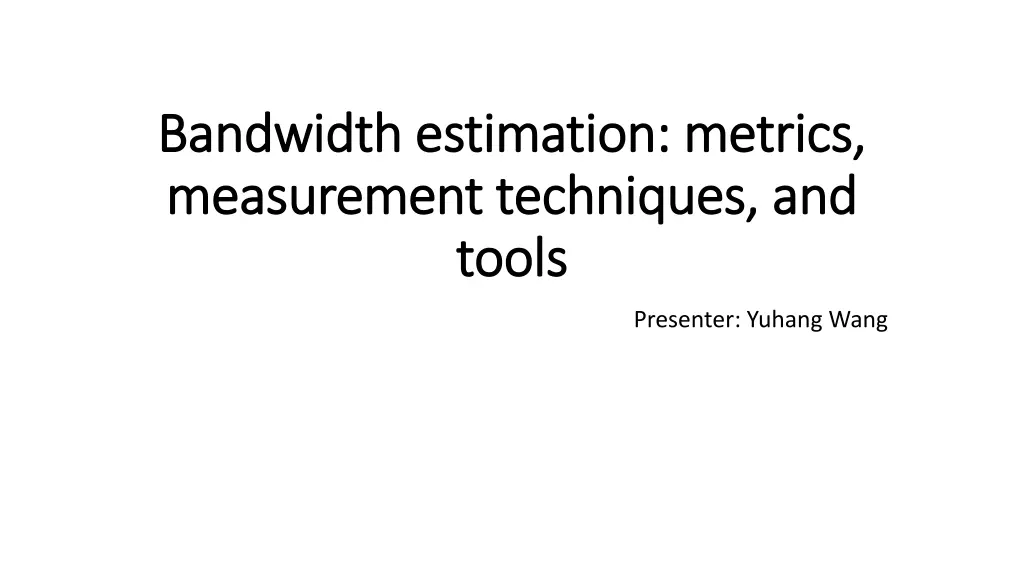
Bandwidth Estimation Metrics and Measurement Techniques
Explore various bandwidth estimation metrics, measurement techniques, and tools for accurate bandwidth assessment. Learn about capacity-related metrics, available bandwidth, bulk transfer capacity, and probing techniques like Variable Packet Size (VPS) for evaluating network bandwidth along a path.
Uploaded on | 0 Views
Download Presentation

Please find below an Image/Link to download the presentation.
The content on the website is provided AS IS for your information and personal use only. It may not be sold, licensed, or shared on other websites without obtaining consent from the author. If you encounter any issues during the download, it is possible that the publisher has removed the file from their server.
You are allowed to download the files provided on this website for personal or commercial use, subject to the condition that they are used lawfully. All files are the property of their respective owners.
The content on the website is provided AS IS for your information and personal use only. It may not be sold, licensed, or shared on other websites without obtaining consent from the author.
E N D
Presentation Transcript
Bandwidth estimation: metrics, Bandwidth estimation: metrics, measurement techniques, and measurement techniques, and tools tools Presenter: Yuhang Wang
Content Content Three Bandwidth-related Metrics Different Techniques for accurate bandwidth estimation Taxonomy of Bandwidth Estimation Tools
Bandwidth Bandwidth- -related Metric: Capacity related Metric: Capacity Individual link Capacity Depending on the file size and the capacity of link layer CL2: capacity of link layer HL2: Link layer header LL3: file size of network layer End-to-End Path Capacity the maximum IP layer rate that the path can transfer from source to sink The minimum link capacity in the path determines the end-to-end capacity
Bandwidth Bandwidth- -related Metric: related Metric: available bandwidth bandwidth available The available bandwidth of a link relates to the unused, or spare , capacity of the link during a certain time period. The average available bandwidth Ai of hop i is given by the unutilized fraction of capacity Ai=(1-ui)Ci. where, ui is the average of instantaneous utilization over the time interval of interest.
Bandwidth Bandwidth- -related Metric: related Metric: Bulk Capacity (BTC) Capacity (BTC) Bulk- -Transfer Transfer- - Bulk-Transfer- Capacity (BTC) is maximum throughput obtainable by a single TCP connection. Affecting factors: transfer size type of cross traffic (UDP or TCP) number of competing TCP connections TCP socket buffer sizes at both sender and receiver sides congestion along reverse (ACK) path size of router buffers and capacity load of each link
Techniques: Variable Packet Size (VPS) probing Techniques: Variable Packet Size (VPS) probing Aim: the capacity of each hop along a path Idea: measuring the RTT from the source to each hop of the path as a function of the probing packet size. Methodology: Forcing probing packets to expire at a particular hop by manipulating Time-To- Live (TTL) field in IP header. Corresponding router discards the probing packets, returning ICMP Time- exceeded error messages to the source. The source uses the received ICMP packets to measure the RTT to that hop
Techniques: Variable Packet Size (VPS) probing Techniques: Variable Packet Size (VPS) probing Delay in the way: serialization delays transmission delay propagation delays time for a packet traverse the link queueing delays-time waiting in buffers of routers or switches Minimum RTT: VPS sends multiple probing packets of a given size VPS assumes that at least one will not encounter any queueing delays Minimum RTT:
Techniques: Variable Packet Size (VPS) probing Techniques: Variable Packet Size (VPS) probing Estimated Capacity at each hop i: 1 ??= ?? ?? 1 Drawback: significant capacity underestimation errors will occur if the measured path includes store-and-forward layer-2 switches .
Techniques: Packet Pair/Train Dispersion (PPTD) Techniques: Packet Pair/Train Dispersion (PPTD) probing probing Packet pair probing is used to measure the end-to- end capacity of a path.
Techniques: Packet Pair/Train Dispersion (PPTD) Techniques: Packet Pair/Train Dispersion (PPTD) probing probing The dispersion, between two packets, ? is: ,Where C is the capacity of the path. Drawback: The measurement is under the assumption that the path is empty of any other traffic.
Techniques: Packet Pair/Train Dispersion (PPTD) Techniques: Packet Pair/Train Dispersion (PPTD) probing probing Packet train probing extends packet pair probing by using multiple back-to-back packets Dispersion rate: Path capacity : C=E[D], with a large number of packets in the chain.
Techniques: Self Techniques: Self- -Loading Periodic Streams ( Loading Periodic Streams (SLoPS SLoPS) ) SLoPS is a recent measurement methodology for measuring end-to- end available bandwidth Methodology: Sending K( 100) same-size packets monitoring variations in one way delays of the probing packets Following the an iterative algorithm similar to binary search
Techniques: Trains of Packet Pairs (TOPP) Techniques: Trains of Packet Pairs (TOPP) Trains of Packet Pairs to estimate the available bandwidth of a network path. Methodology: sending many packet pairs at gradually increasing rates. Comparing the link rate at every hop. Measured rate at receiver: Where RC=C-A, C is the capacity of end-to-end path, A is the available band-width.
Techniques: Other bandwidth estimation Techniques: Other bandwidth estimation methodologies methodologies Methodology estimates the utilization of a single bottleneck Methodology estimates available bandwidth using different packet stream patterns from those of SLoPS and TOPP Methodology estimates the capacity of targeted subpaths in a path.
Taxonomy of Taxonomy of B Bandwidth Estimation Tools andwidth Estimation Tools
Discussion Do you know some new techniques to measure bandwidth-related metric? Is there any drawbacks in them?
